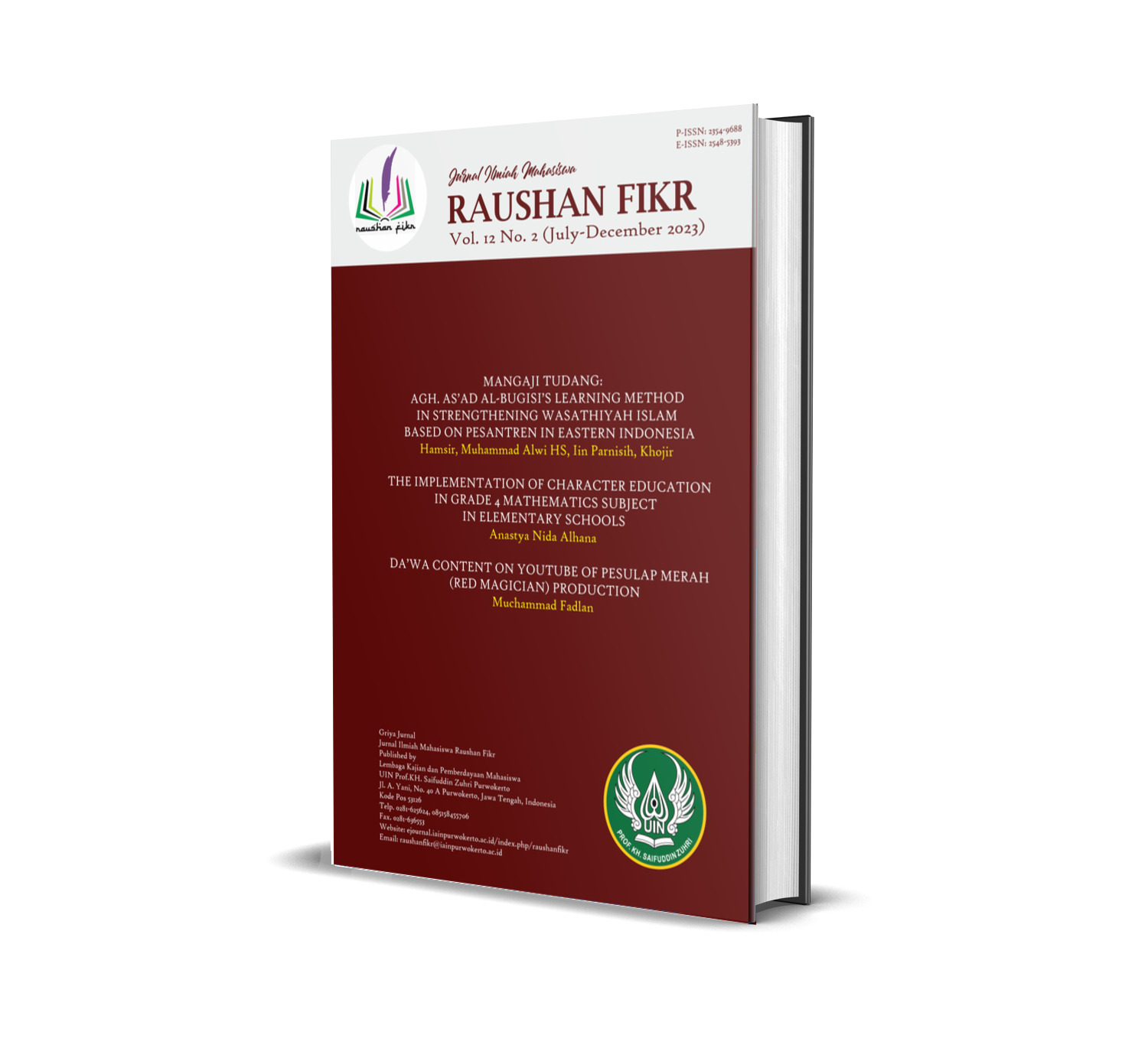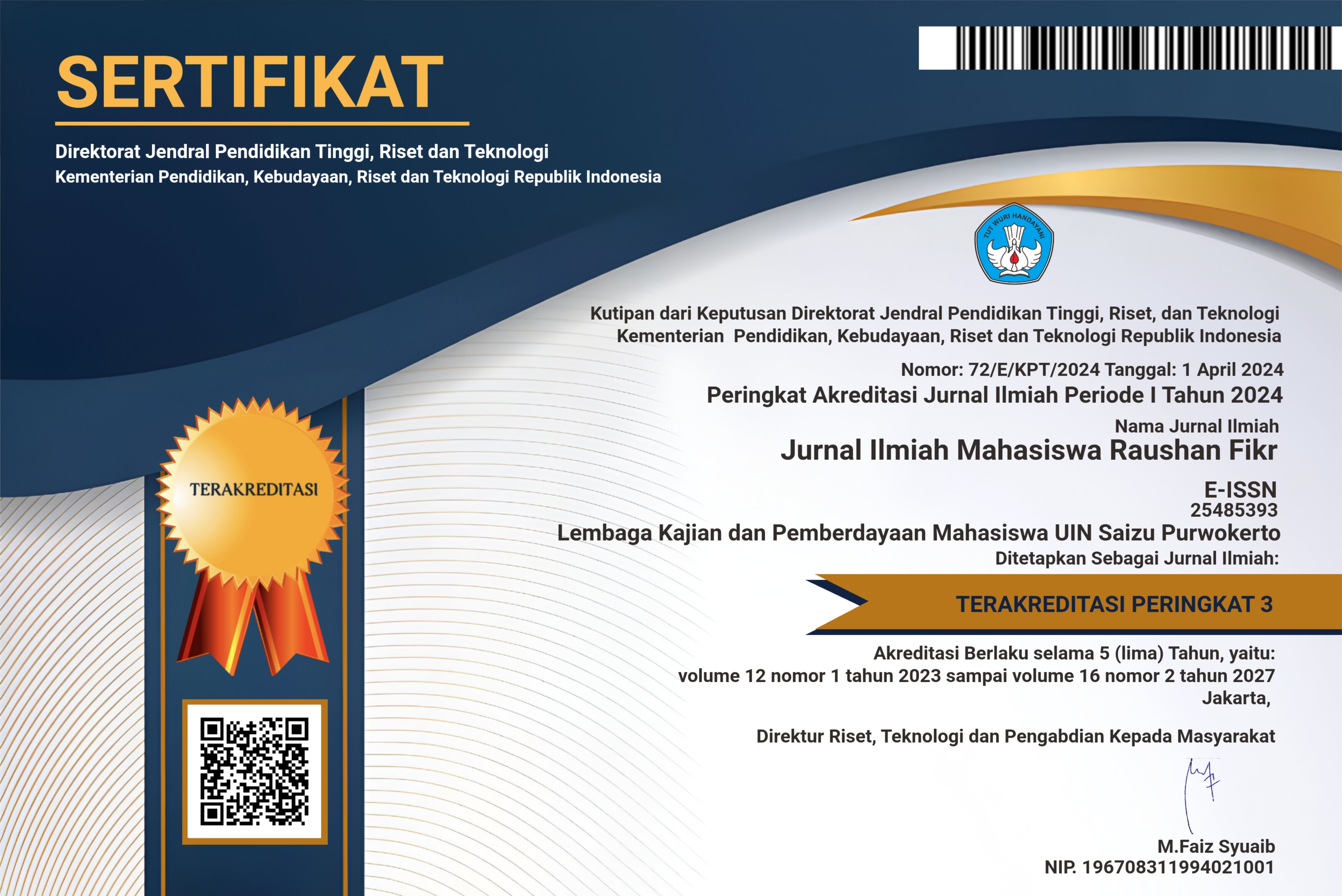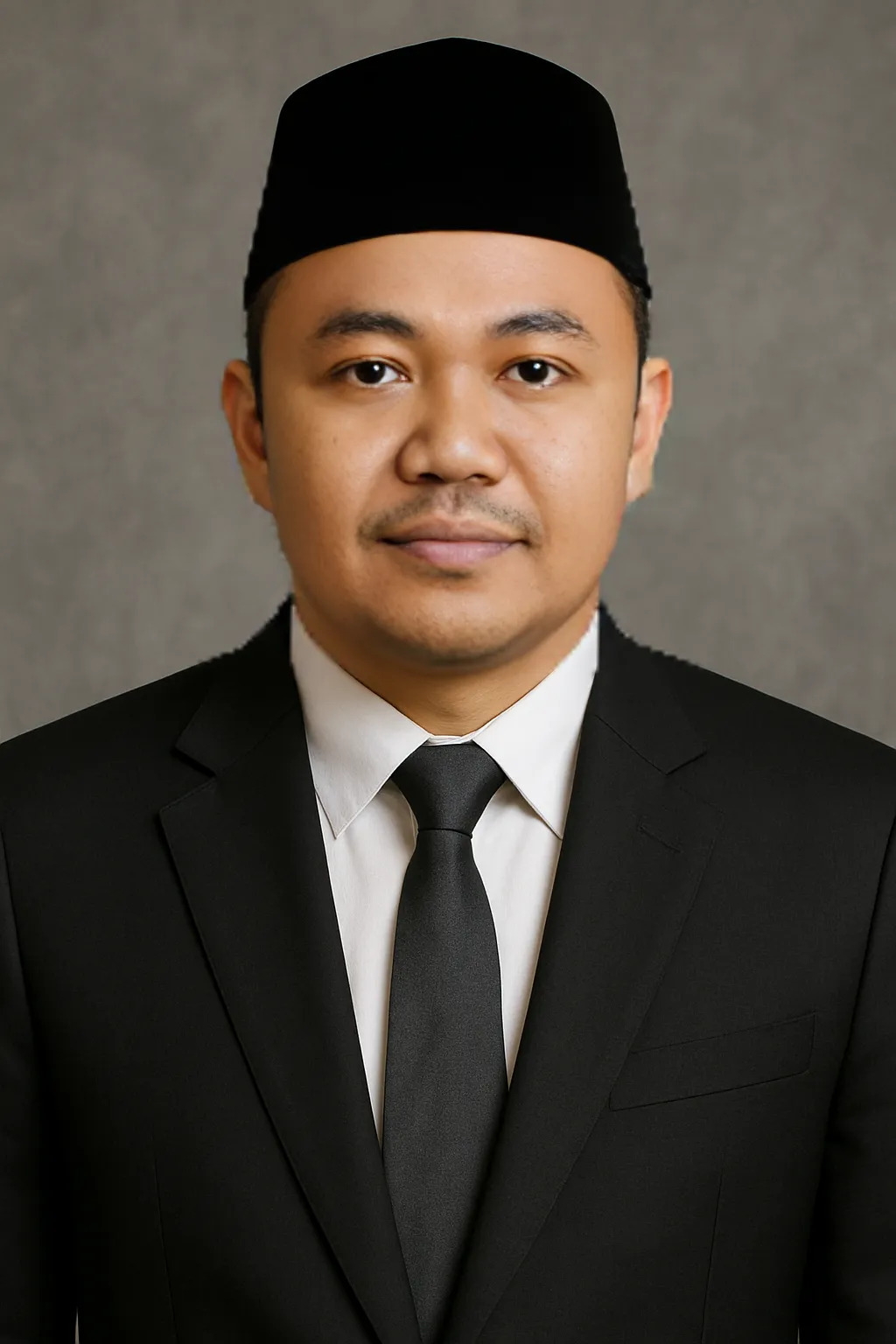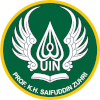Spiritual Harmony: The Practice of Living the Qur’an and Hadith Through the Prayer Wirid Tradition in West Sulawesi
DOI:
https://doi.org/10.24090/jimrf.v12i2.12362Kata Kunci:
Spiritual Harmony, Living Qur’an-Hadith, Wirid, TraditionAbstrak
This article seeks to explore the meanings ascribed to the recitation of wirid prayer within Muslim communities in West Sulawesi. Wirid prayer represents an important aspect of Muslim devotional practice, extending beyond a simple series of prayers or dhikr to encompass various interpretations within the local cultural context. This study employs a qualitative approach to examine the relevance and significance of wirid recitations in the daily lives of the people in West Sulawesi, and how these practices shape their religious identity. The study identifies three primary meanings associated with the practice of wirid prayer. First, the recitation is understood as a form of spiritual healing, reflecting the community's belief in its ability to provide both physical and mental well-being. Secondly, the recitation is seen as Istiadzah, a form of protection believed to shield individuals from potential threats, both physical and non-physical. This demonstrates the community’s perception of the efficacy of wirid as a safeguard. Lastly, the recitation of wirid prayer is perceived as a jampi or mantra, another form of protection believed to safeguard individuals from various dangers.Unduhan
Referensi
Ali, M. (2011). Muslim diversity: Islam and local tradition in Java and Sulawesi, Indonesia. Indonesian Journal of Islam and Muslim Societies, 1(1), 1–35. https://doi.org/10.18326/ijims.v1i1.1-35
Aufa, N. S., Maimun, M., & Junaedi, D. (2020). LIVING QUR‘AN DALAM TRADISI SELAWATAN DI MAJELIS SELAWAT AR-RIZQY CIREBON: Pendekatan Fenomenologi. Diya Al-Afkar: Jurnal Studi Al-Quran Dan Al-Hadis, 8(02), 265. https://doi.org/10.24235/diyaafkar.v8i02.7395
Azarpour, E., Moraditochaee, M., & Bozorgi, H. R. (2014). STUDY MEDICINAL PLANTS IN HOLY QURAN. The International Journal of Plant, Animal and Environmental Sciences, 2014. https://api.semanticscholar.org/CorpusID:53003461
Azka, I., Fathur Baldan Haramain, & Mohammad Cholil Alwi. (2024). Harmonization of Tradition and Islam: Mediating Culture and Religious Beliefs in Maccera Tasi Ritual in Luwu, South Sulawesi. Heritage of Nusantara: International Journal of Religious Literature and Heritage, 13(1), 30–56. https://doi.org/10.31291/hn.v13i1.736
Bensaid, B., & Machouche, S. ben T. (2017). Memorizing the Words of God: Special Reference to ‘Abdul Rahman Ibn Khaldun (D. 1406 A.D.). Religious Education, 112(4), 339–350. https://doi.org/10.1080/00344087.2016.1224001
Bhuiyan, P., Khatun, Z., Jahan, S., Tanvir Morshed, M., Rahman, S., Anik Afsana, N., Nasrin, D., & Rahmatullah, M. (2013). Use of Quranic verses, amulets, numerology, and medicinal plants for treatment of diseases: A case study of a healer in Narsinghdi district, Bangladesh. American-Eurasian Journal of Sustainable Agriculture, 7(5), 415–425.
Buhori. (2017). Islam dan tradisi lokal di nusantara. Al-Maslahah, 13–2(2), 229–246.
Devi, D., & Rustina, Y. (2019). Impact of Qur’an Recitation Therapy on Physiologic Responses in Neonates Admitted in Nicu: a Systematic Review. Journal of Islamic Nursing, 4(2), 9. https://doi.org/10.24252/join.v4i2.9718
Dweirj, L. (2023). The Qur’an: An Oral Transmitted Tradition Forming Muslims Habitus. Religions, 14(12). https://doi.org/10.3390/rel14121531
Fahmi, R. (2024). Cultural Harmony: East Loloan Traditional Marriage in Jembrana Regency (A Comparative Study of Islamic Law and Customary Law). Quru’: Journal of Family Law and Culture, 2(1), 48–72.
Farizy, H. S. (2024). The Interaction of the Holy Qur’an with the World. Al-Bunyan: Interdisciplinary Journal of Qur’an and Hadith Studies, 2(1), 9–14. https://doi.org/10.61166/bunyan.v2i1.21
Fithrianto, M. N., Andrianata, M., & Suharsono, J. (2024). The Effect of Community Participation, Government Policy, and Sharia Financial Education on Sharia Economic Development in West Java. West Science Social and Humanities Studies, 2(07), 1166–1178. https://doi.org/10.58812/wsshs.v2i07.1084
Hadis, D. A. D. A. N. (2024). IMPLEMENTASI METODOLOGI PENDIDIKAN. 16(1), 76–89.
Hasan, M. Z. (2020). Resepsi Al-Qur’an Sebagai Medium Penyembuhan Dalam Tradisi Bejampi Di Lombok. Jurnal Studi Ilmu-Ilmu Al-Qur’an Dan Hadis, 21(1), 133. https://doi.org/10.14421/qh.2020.2101-07
Hasbullah, H., Jamrah, S. A., Syafitri, R., & Zulkifli, N. A. (2022). Dialectic of Religion and Tradition: Investigating Remote Indigenous Communities Belief in Riau, Indonesia. Religious: Jurnal Studi Agama-Agama Dan Lintas Budaya, 6(1), 59–70. https://doi.org/10.15575/rjsalb.v6i1.17571
Henry, H. M. (2015). Spiritual Energy of Islamic Prayers as a Catalyst for Psychotherapy. Journal of Religion and Health, 54(2), 387–398. https://doi.org/10.1007/s10943-013-9780-4
Hutabarat, F. (2023). Navigating Diversity: Exploring Religious Pluralism and Social Harmony in Indonesian Society. European Journal of Theology and Philosophy, 3(6), 6–13. https://doi.org/10.24018/theology.2023.3.6.125
Indrawardana, I. (2014). Berketuhanan dalam Perspektif Kepercayaan Sunda Wiwitan. Melintas, 30(1), 105. https://doi.org/10.26593/mel.v30i1.1284.105-118
Ismanto, R., & Amin, M. (2023). Integrasi Budaya Lokal dalam Praktik Keagamaan Persfektif Hukum Islam: Studi Kesenian Dambus dalam Penggalangan Dana Pembangunan Masjid di Pangkalpinang. Scientia: Jurnal Hasil Penelitian, 8(2), 89–99. https://doi.org/10.32923/sci.v8i2.3440
Julianto, V., & Subandi, -. (2015). Membaca Al Fatihah Reflektif Intuitif untuk Menurunkan Depresi dan Meningkatkan Imunitas. Jurnal Psikologi, 42(1), 34. https://doi.org/10.22146/jpsi.6941
Khalil, al-Q. M. (2007). Studi Ilmu Ilmu Quran. Pustaka Book Populer.
Khotijah, S. (2023). Representasi Ideologis Muhammadiyah dalam Wirid Sebelas Ayat: Studi Living Qur’an di Desa Sidoharjo, Samigaluh, Kulon Progo. Muslim Heritage, 8(2), 189–200. https://doi.org/10.21154/muslimheritage.v8i2.6989
Machendrawaty, N., & Safei, A. A. (2001). Pengembangan masyarakat Islam : dari ideologi, strategi sampai tradisi. Remaja Rosdakarya.
Mansoer, M., Kaltsum, L. U., & Mulyadi, Y. (2018). the Qur’an and Indonesian Community Culture: the Qur’an As an Amulet Among Indigenous People. 137(Icqhs 2017), 249–255. https://doi.org/10.2991/icqhs-17.2018.39
Mudin, K., Safri, E., Zulfikri, Z., & Saputra, E. (2021). Fiqh Al-Hadis: Studi Terhadap Hadis Membaca Al-Fatihah Bagi Makmum Pada Majalah Soerti. Jurnal Ulunnuha, 10(1), 51–64. https://doi.org/10.15548/ju.v10i1.1887
Mujahidin, A. (2018). Indonesian Context of the Meaning of Qur’an: a Study on the Verses of Powers in Tafsir Al-Azhar and Al-Mishbah. 137(Icqhs 2017), 299–308. https://doi.org/10.2991/icqhs-17.2018.46
Mursalin, H. (2024). Wawasan Al-Qur’an tentang Pendidikan dan Pengajaran. An-Nidzam: Jurnal Manajemen Pendidikan Dan Studi Islam, 14(1), 43–68.
Naim, N. (2019). Islamic Jurisprudence for Diversity: From Theological-Normative Reason to Progressive Contextual Reasoning. Al-’Adalah, 15(1), 51. https://doi.org/10.24042/adalah.v15i1.2621
Nazzal, A. (2005). The pragmatic functions of the recitation of Qur’anic verses by Muslims in their oral genre. Pragmatics, 15(2–3), 251–273. https://doi.org/https://doi.org/10.1075/prag.15.2-3.05naz
Pelras, C. (1985). Religion, Tradition and the Dynamics of Islamization in South-Sulawesi. Archipel, 29(1), 107–135. https://doi.org/10.3406/arch.1985.2226
Putri, A. M., Rosana, E., & Salim, L. (2024). Tradisi Ruwat Bumi Dan Harmonisasi Umat Beragama di Desa Ambarawa Barat Kecamatan Ambarawa Kabupaten Pringsewu. RESIPROKAL: Jurnal Riset Sosiologi Progresif Aktual, 6(1), 12–37. https://doi.org/10.29303/resiprokal.v6i1.458
Rahmayani, R., Ramli, R., Qadaruddin, M., Iskandar, I., & Halim, A. (2023). TVRI Sulbar Program In Preserving Mandar Culture In West Sulawesi. Jurnal Dakwah Dan Komunikasi, 8(2), 191. https://doi.org/10.29240/jdk.v8i2.8500
Ramadhana, N., Al Muhdhar, M. H. I., & Sulistijiono. (2023). The existence of Malaqbiq Tau Mandar local culture to empower students’ educational character. Cakrawala Pendidikan, 42(3), 577–585. https://doi.org/10.21831/cp.v42i3.56514
Rasmussen, A. K. (2001). The Qur’ân in Indonesian Daily Life: The Public Project of Musical Oratory. Ethnomusicology, 45(1), 30–57. https://doi.org/10.2307/852633
Rostiyati, A., Sofianto, K., Adeng, Erwantoro, H., Andayani, R., & Tismara, H. (2024). Interpreting Sundanese ritual practices at the mikul lodong ceremony in Cipatat, West Bandung, Indonesia. Cogent Social Sciences, 10(1), 2334091. https://doi.org/10.1080/23311886.2024.2334091
Ruslan, I., Amri, F., & Yusriadi, Y. (2024). Religion, Education, and Maintaining Ethno-religious Harmony in Sanggau, West Kalimantan. Dinamika Ilmu, 24(1), 111–126. https://doi.org/10.21093/di.v24i1.8763
Saniotis, A. (2018). Understanding Mind/Body Medicine from Muslim Religious Practices of Salat and Dhikr. Journal of Religion and Health, 57(3), 849–857. https://doi.org/10.1007/s10943-014-9992-2
Sholihan, & Nurul Ayyami Shalehati. (2024). Pendampingan Belajar Membaca Al-Quran Dengan Benar Bagi Siswa SD dan MI Dusun Labuhan Kecamatan Tambak. SAMBARA: Jurnal Pengabdian Kepada Masyarakat, 2(2), 7–23. https://doi.org/10.58540/sambarapkm.v2i2.603
Suryo, N., & Syafi’i, M. H. (2024). The Effect of Al-Qur’an Recitation as Systematic Audio Therapy on Patients with Neurodegenerative Progressive Supranuclear Palsy (PSP): A Review. Journal of Islamic Communication and Counseling, 3(2), 112–131. https://doi.org/10.18196/jicc.v3i2.80
Sutisna, M. A. R. (2024). Potensi ekonomi dan pemanfaatan sumber daya perikanan tangkap di Sulawesi Barat. Gender, Human Development, and Economics, 1(1), 20–27. https://doi.org/10.61511/ghde.v1i1.2024.590
Syafruddin, S., & Badollahi, M. Z. (2023). West Sulawesi Maritime Tourism Development Strategy. International Journal Papier Public Review, 4(3), 10–17. https://doi.org/10.47667/ijppr.v4i3.243
Wahid, A., & Rahim, R. A. A. (2024). Islam’s Integration with Local Culture through the Custom of Reciting the Qur’an at Death. Jurnal Iman Dan Spiritualitas, 4(1), 51–58. https://doi.org/10.15575/jis.v4i1.32456
Wilson, M. B. (2020). Translations of the Qur’an: Islamicate Languages. In M. Shah & M. A. Haleem (Eds.), The Oxford Handbook of Qur’anic Studies (p. 0). Oxford University Press. https://doi.org/10.1093/oxfordhb/9780199698646.013.51
Yono, Y. (2020). Sikap Manusia Beriman Menghadapi Covid 19. Mizan: Journal of Islamic Law, 4(1), 121–130. https://doi.org/10.32507/mizan.v4i1.616
Zadeh, T. (2008). ‘Fire Cannot Harm It’: Mediation, Temptation and the Charismatic Power of the Qur’an. Journal of Qur’anic Studies, 10(2), 50–72. https://doi.org/10.3366/E1465359109000412
Unduhan
Diterbitkan
Cara Mengutip
Terbitan
Bagian
Lisensi
Hak Cipta (c) 2023 M. Dalip, Muhammad Yunan, Abdul Gaffar Haris

Artikel ini berlisensiCreative Commons Attribution-NonCommercial-ShareAlike 4.0 International License.
Authors who publish with this journal agree to the following terms:
- Authors retain copyright and grant the journal right of first publication with the work simultaneously licensed under a Creative Commons Attribution-NonCommercial-ShareAlike 4.0 International License that allows others to share the work with an acknowledgement of the work's authorship and initial publication in this journal.
- Authors are able to enter into separate, additional contractual arrangements for the non-exclusive distribution of the journal's published version of the work (e.g., post it to an institutional repository or publish it in a book), with an acknowledgement of its initial publication in this journal.
- Authors are permitted and encouraged to post their work online (e.g., in institutional repositories or on their website) prior to and during the submission process, as it can lead to productive exchanges, as well as earlier and greater citation of published work (See The Effect of Open Access).
















